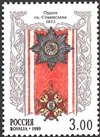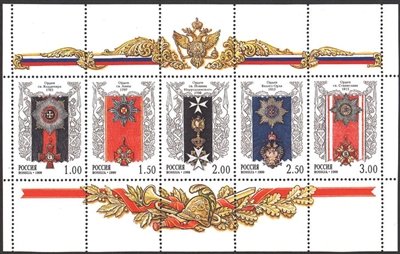25.02.1999
Painter – Zaytsev L.
Stamps per sheets: 36 (6x6 stamps).
Paper - coated; manufacturing process - offset + varnish; perforation - comb 12 x 12½.
 |
||
The Order of St.Vladimir (1782). One of the highest awards of the Russian Empire, the Order was founded by Empress Catherine II and had 4 classes. The Order was awarded for military and civil merits. The Cross of the Order is decorated with red enamel with black and gold outlines. In the central medallion there is a Great Prince mantle under a crown with "CV" monogram (standing for St.Vladimir). In the centre of the eight-pointed star there is the motto of the Order: "Benefit, honour, and glory", as well as the letters "CRKV" standing for the Saint Apostolic Prince Vladimir. The Order is worn on a red sash with wide black stripes along the sides.
| Face value | Size | Description | Price, mint | Price, used | Quantity |
|---|---|---|---|---|---|
| 1.00 | 30×42 | The Order of St.Vladimir (1782). One of the highest awards of the Russian Empire, the Order was founded by Empress Catherine II and had 4 classes. The Order was awarded for military and civil merits. The Cross of the Order is decorated with red enamel with black and gold outlines. In the central medallion there is a Great Prince mantle under a crown with "CV" monogram (standing for St.Vladimir). In the centre of the eight-pointed star there is the motto of the Order: "Benefit, honour, and glory", as well as the letters "CRKV" standing for the Saint Apostolic Prince Vladimir. The Order is worn on a red sash with wide black stripes along the sides. multicolor |
1.00 | 0.20 | 250000 |
№ 485
 |
||
The Order of St.Anna (1797) is one of the honourable awards in the Russian Empire. It was introduced in Russia by Paul I in 1797. The order was awarded for military and civil achievements and had four classes. The order was founded by Duke Carl Friedrich Golstein-Gottorp in 1735 to commemorate the memory of his wife Anna Petrova, the daughter of Peter I. In 1743 the Duke's son, the future Emperor Peter III was declared heir to the Russian throne, and the Order began to be given to Russian citizens. Class Four award was worn on cold steel ("The Anna weapon"), Class Three was a cross worn on the breast, Class Two was a cross worn on the neck, and Class One was a cross worn on the right hip on a sash over the left shoulder. The Star of the order was worn on the right side of the breast. The Cross is made of red enamel, with the image of St. Anna in the central medallion. In the centre of the eight-pointed star there was a medallion with the motto of the Order in Latin: "Amantibus Justitiam, Pietatem, Fidem". The sash of the Order is red brimmed with gold.
| Face value | Size | Description | Price, mint | Price, used | Quantity |
|---|---|---|---|---|---|
| 1.50 | 30×42 | The Order of St.Anna (1797) is one of the honourable awards in the Russian Empire. It was introduced in Russia by Paul I in 1797. The order was awarded for military and civil achievements and had four classes. The order was founded by Duke Carl Friedrich Golstein-Gottorp in 1735 to commemorate the memory of his wife Anna Petrova, the daughter of Peter I. In 1743 the Duke's son, the future Emperor Peter III was declared heir to the Russian throne, and the Order began to be given to Russian citizens. Class Four award was worn on cold steel ("The Anna weapon"), Class Three was a cross worn on the breast, Class Two was a cross worn on the neck, and Class One was a cross worn on the right hip on a sash over the left shoulder. The Star of the order was worn on the right side of the breast. The Cross is made of red enamel, with the image of St. Anna in the central medallion. In the centre of the eight-pointed star there was a medallion with the motto of the Order in Latin: "Amantibus Justitiam, Pietatem, Fidem". The sash of the Order is red brimmed with gold. multicolor |
1.50 | 0.30 | 250000 |
№ 486
 |
||
The Order of St.John of Jerusalem (1798). The Order was awarded for military deeds and civil achievements and had three classes. The history of the Order goes back to the Knights Hospitaller, a spiritual order of knights established by the crusaders in Palestine in the early 12th century. The badge of the order is an eight-pointed enamelled cross on a black sash. After the crusades (1096-1270) the Order of St.John moved to Malta and became known as the Maltese Order. In 1798 Napoleon took over Malta and Russian Emperor Paul I (1754-1801) proclaimed himself the Grand Master. The order existed in Russia till the end of Paul the First reign.
| Face value | Size | Description | Price, mint | Price, used | Quantity |
|---|---|---|---|---|---|
| 2.00 | 30×42 | The Order of St.John of Jerusalem (1798). The Order was awarded for military deeds and civil achievements and had three classes. The history of the Order goes back to the Knights Hospitaller, a spiritual order of knights established by the crusaders in Palestine in the early 12th century. The badge of the order is an eight-pointed enamelled cross on a black sash. After the crusades (1096-1270) the Order of St.John moved to Malta and became known as the Maltese Order. In 1798 Napoleon took over Malta and Russian Emperor Paul I (1754-1801) proclaimed himself the Grand Master. The order existed in Russia till the end of Paul the First reign. multicolor |
2.00 | 0.40 | 250000 |
№ 487
 |
||
The Order of the White Eagle (1815), one of the most distinguished awards of the Russian Empire, was granted for both military and civil achievements. This is one of the oldest Polish orders, it was founded by King August II in 1705. In 1815 after the Napoleonic France was defeated the order was re-established in the Polish Kingdom which became part of the Russian Empire. The Russian Empire Crown replaced the Polish crown on the badges of the order, and the cross of the order with a white eagle displayed was placed upon the Russian black double-headed eagle. In the centre of the eight-pointed star there is a medallion bearing the motto of the order in Latin : "Pro Fide, Rege et Lege".
| Face value | Size | Description | Price, mint | Price, used | Quantity |
|---|---|---|---|---|---|
| 2.50 | 30×42 | The Order of the White Eagle (1815), one of the most distinguished awards of the Russian Empire, was granted for both military and civil achievements. This is one of the oldest Polish orders, it was founded by King August II in 1705. In 1815 after the Napoleonic France was defeated the order was re-established in the Polish Kingdom which became part of the Russian Empire. The Russian Empire Crown replaced the Polish crown on the badges of the order, and the cross of the order with a white eagle displayed was placed upon the Russian black double-headed eagle. In the centre of the eight-pointed star there is a medallion bearing the motto of the order in Latin : "Pro Fide, Rege et Lege". multicolor |
2.50 | 0.50 | 250000 |
№ 488
 |
||
The Order of St.Stanislav (1815), the lowest order of the Russian Empire, was granted for military and civil merits. The order, which had three classes, was founded by Polish king Stanislav August Ponjatovsky in 1765 to commemorate the life of St.Stanislav, a Krakov bishop of the 11th century. In 1815 after Napoleon was defeated the order was re-established in the Polish Kingdom which became part of the Russian Empire. Since 1815 the order was awarded to Polish citizens in the name of Emperor Alexander. The badge of the order was a red enamelled cross with four Polish eagles between the points. The central medallion bore the image of St.Stanislav and his Latin initials SS. Later when the Order became a Russian award the image of the bishop was removed leaving only his initials. The Polish eagles were replaced by Russian double-headed eagles. In the centre of the eight-pointed star there is a medallion bearing the motto of the order in Latin : "Praemirando incitat". The sash of the order is red brimmed with white.
| Face value | Size | Description | Price, mint | Price, used | Quantity |
|---|---|---|---|---|---|
| 3.00 | 30×42 | The Order of St.Stanislav (1815), the lowest order of the Russian Empire, was granted for military and civil merits. The order, which had three classes, was founded by Polish king Stanislav August Ponjatovsky in 1765 to commemorate the life of St.Stanislav, a Krakov bishop of the 11th century. In 1815 after Napoleon was defeated the order was re-established in the Polish Kingdom which became part of the Russian Empire. Since 1815 the order was awarded to Polish citizens in the name of Emperor Alexander. The badge of the order was a red enamelled cross with four Polish eagles between the points. The central medallion bore the image of St.Stanislav and his Latin initials SS. Later when the Order became a Russian award the image of the bishop was removed leaving only his initials. The Polish eagles were replaced by Russian double-headed eagles. In the centre of the eight-pointed star there is a medallion bearing the motto of the order in Latin : "Praemirando incitat". The sash of the order is red brimmed with white. multicolor |
3.00 | 0.60 | 250000 |
Sheetlet
Stamps per sheet: 5 (5x1 stamps).
Paper - coated; manufacturing process - offset + varnish; perforation - comb 12 x 12½.
The margins of the sheetlet feature the Russian double-headed eagle, symbols of the glory of the Russian arms, and a horizontal band with the colours of the Russian flag.
Sheetlet print quantity - 55000.
 |
||
| 484 | 485 | 486 | 487 | 488 |
The margins of the sheetlet feature the Russian double-headed eagle, symbols of the glory of the Russian arms, and a horizontal band with the colours of the Russian flag.
Category:
State and Power : State symbols. Armory
Stamps:
The History of Russia.
The History of Russia.
The History of Russia. Reforms of Peter the Great.
History of Russian State. Orders of Russia.
History of the Russian state. Emperor Nicholas II.
The History of Russia. Alexander I (1777-1825).
The History of Russia.
History of Russian State. 850th Birth Anniversary of Vsevolod the Big Nest.
History of Russian State. 250th Birth Anniversary of Paul I, Russian Emperor.
The history of Russia. The 275th birth anniversary of Empress Catherine II.
The 275th birth anniversary of A.V.Suvorov (1730-1800), commander.
History of Russian State. Emperor Alexander II (1811-1881).
History of Russian State. Emperor Alexander II (1811-1881).
The history of the Russian State. Alexander the 3d (1845-1894), the emperor.
The history of the Russian State. Alexander the 3d (1845-1894), the emperor.
FDC:
no data





